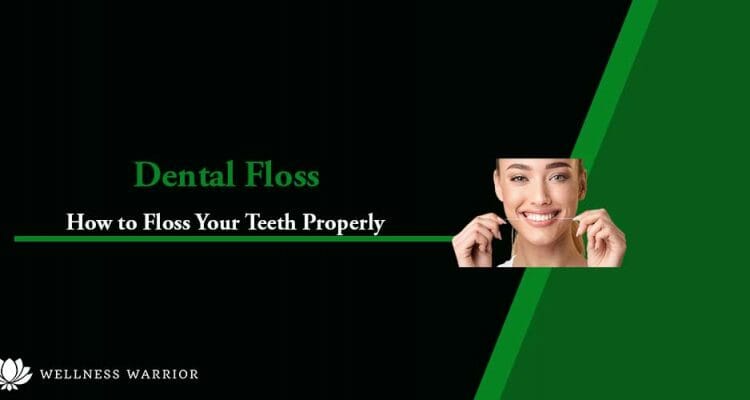According to a clinical review from Croatia, dental flossing can reduce gingivitis and prevent decay.
For some, this oral hygiene technique can also reduce the risk of tooth loss.
But, how effective is this oral hygiene?
In this article, we will have an overview of dental flossing, what are its other benefits, a step-by-step guide on how to properly floss your teeth, and details on how to choose the best dental floss.
How To Floss Your Teeth Properly: Types of Floss, And Guide

What is Dental Flossing
The primary purpose of dental floss is to clean the interproximal areas between adjacent teeth. When you eat, some food gets stuck in between your crevices and can eventually cause plaque.
According to the American Dental Association, around 80% of the plaque can be removed by flossing, and patients with braces would surely benefit from it.
However, this does not mean that flossing alone is better than brushing your teeth.
The effectiveness of using floss is higher when combined with brushing.
When you brush your teeth, make sure to follow a proper brushing technique as well.
Types of Dental Floss
There are different types of dental floss on the market.
There are regular floss and floss picks but not everyone can use both of these types. For the floss picks, they may come in C-shape and Y-shape.
How to use them will be discussed in the next sections.
Additionally, these flosses contain different components and because of their different contents, their ability to remove plaque varies significantly. Some of these include the following:
- Floss threaders – These are made from many strands of nylon and glide easily in between the teeth.
- Unwaxed and waxed floss – Both of these are made from nylon but the former is covered with a light wax coating. According to some experts, unwaxed floss can absorb food particles better while waxed floss can glide in between the teeth better.
- Flavored and unflavored floss – Usually, the flavored floss comes in mint and cinnamon that contains fluoride.
- Tape floss or dental tape – Dental tape is usually used by individuals with larger spaces between their teeth. A dental tape is broader than regular floss and does not break easily.
- Super flosses – This floss is made from yarn-like material that is commonly used to clean braces or dental bridges.
- Polytetrafluorethylene flosses – Also known as PTFE flosses, these are made from high-tech Gore-Tex fabric that is perfect for individuals with crowded teeth.
Again, not everyone can use these floss types. Depending on the condition of your teeth, you might have to choose the best suitable one for you. For better and safer choices, seek advice from a dentist.
Proper Way to Floss Your Teeth
So, what is the proper way of flossing? In this section, we will discuss the step-by-step guide on using floss for individuals with or without braces.
First, cut around 20 inches of dental floss or about an arm’s length piece of floss. Hold the floss correctly by winding most of it around both of your middle fingers. You should only leave around 2 inches of floss for your teeth but you put more space through until you feel comfortable.
Some people use their index fingers but using the middle fingers is the proper way.
Next, hold the floss taut using your thumbs and index fingers. Your thumbs and index fingers play a big role in flossing as they will facilitate proper gliding of the floss.
Then, place the floss between your teeth and glide it up and down. Make sure to rub the floss against both sides and back the back side of each tooth. Also, avoid gliding the floss into your gums.
After that, as the floss reaches your gums, curve the floss to form a C-shape. When you move on to the next tooth, repeat these steps and make sure to use a clean section of floss.
Flossing with Braces
For those with braces, dentists would agree that using dental floss correctly might be a little difficult. To make it simple, consider the following step-by-step guide:
- Cut off around 24 inches of regular floss or about an arm’s length piece of floss. If you can, waxed floss is better.
- Stand in front of a mirror to see how the floss is going around your mouth. This will also allow you to clean a tooth correctly.
- Floss between your teeth and the main wire and press the floss as gently as you can.
- Move the floss up and down along the sides of both teeth.
- When you floss your top teeth, go up the side of one tooth until you reach the gingiva.
- Carefully remove the floss and avoid popping the floss out of your tooth.
- Repeat these steps as you turn from one tooth to another, until you reach the last tooth.
As you turn from another tooth, do not forget to use clean sections of the floss. This is another way to use dental floss correctly while having braces.
If you want a safer way to floss, you can consider the services of dentists as well.
When is the Right Time to Do A Flawless Floss
Generally, it is recommended to floss and then brush your teeth using a soft-bristle toothbrush. According to the American Dental Association, it is recommended to floss at least once a day.
Benefits of Flossing Your Teeth
We all know that flossing can provide cleaner and better oral health when combined with brushing.
But, did you know that there are other benefits you can get from flossing? In this section, we will discuss some of these.
1) Preventive Oral Care
Millions of bacteria can be found in your oral cavity and these can cause oral problems, especially when they get trapped in between your teeth.
When done properly, the food debris that cannot be reached by brushing can be removed, thereby preventing bacteria buildup and then turning to plaque.
Remember, cleaning is a lot cheaper than oral surgery or treatment.
So, do not take flossing, preventing, or removing plaque for granted, especially when you can do it in the comfort of your home.
2) Prevents Tartar Build-Up and Tooth Decay
Keep in mind that it does not take long for plaque to pile up on your teeth. It can constantly form on your teeth throughout the day.
When you do not remove plaque, it can harden and turn into tartar. Fortunately, daily flossing can help you get rid of this plaque and prevent its formation.
Although a dentist can help you remove tartar or plaque by getting treatment, your money can be removed from your pocket, too!
3) Prevents Bad Breath
The food debris trapped in between your teeth can cause an unpleasant odor that can cause embarrassment.
Fortunately, regular flossing can prevent you from experiencing this smelly odor and can keep your breath fresh.
If you are looking for treatment for bad breath, dental floss might be the solution! You can consider mouthwashes but these are temporary fixes only.
4) Prevents Gum Disease and Other Gum Line Infections
When you neglect your oral hygiene, you are risking the health of your gingiva.
Not flossing may increase the risk of periodontal disease and gingivitis and increase the need for dental services.
Periodontal disease is an infection in the gumline.
The diagnosis of this condition can be confirmed after getting panoramic services. Eventually, this gum disease can destroy the bone that supports your teeth.
On the other hand, gingivitis is a mild form of the disease in the gumline.
This condition is characterized by inflammation, redness, and irritation in the gumline.
If you do not floss, you might experience extreme dental cavities.
Remember, plaque is very acidic and if you do not remove it, it can damage your gums.
If infected gums are not subjected to treatment, they can lead to root canal treatment and tooth loss.
A diagnosis and advice can be given by dentists and if these dental conditions are not treated as soon as possible, expensive dental services might be needed.
When you start to floss, it is normal to experience mild bleeding.
Do not be alarmed and just continue adding flossing to your daily oral routine.
However, if bleeding continues even after you have flossed, seek medical services as soon as possible.
5) Reduces the Risk of Respiratory Disease
Did you know that, aside from promoting oral health, using dental floss can also reduce the risk of respiratory diseases, such as asthma, emphysema, pneumonia, bronchitis, and COPD?
Although a healthy mouth and teeth are not directly linked to them, having good oral hygiene can prevent them by preventing bacteria from entering the respiratory system.
For these reasons, it is safe to say that the use of floss can prevent getting medical services related to overall health.
How to Choose the Best Dental Floss
Choosing dental floss depends on the condition of your teeth or if you are wearing braces. Some of the factors you should consider before buying one depend on the following:
- Tightness of teeth
- The contour of the gingival tissue or gums
- The roughness of the crevices or interproximal area
- The user’s ability to use the floss
Take note that there are flossing aids for individuals who have a hard time using a floss.
Some of the flossing aids include a flossing stick, dental floss holder, vibrating dental flosser, and water flosser.
Final Thoughts
Indeed, using floss can improve both teeth and mouth health.
That is why it is highly advised to do flossing as a regular habit.
When you floss, it is vital to follow the correct steps and time.
Additionally, depending on your teeth’s condition, certain flosses should be specifically used. For those with braces, careful flossing is essential.
Although a dentist can provide treatment and services when it comes to mouth and teeth problems, prevention will always be better than cure.
